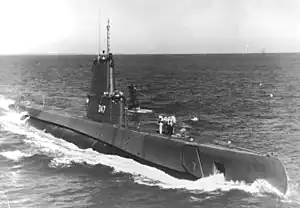USS Cubera
USS Cubera (SS-347), a Balao-class submarine, was a ship of the United States Navy named for the cubera, a large fish of the snapper family found in the West Indies.
 | |
| History | |
|---|---|
| Name | USS Cubera |
| Builder | Electric Boat Company, Groton, Connecticut[1] |
| Laid down | 11 May 1944[1] |
| Launched | 17 June 1945[1] |
| Commissioned | 19 December 1945[1] |
| Decommissioned | 5 January 1972[1] |
| Stricken | 5 January 1972[2] |
| Identification | SS-347 |
| Fate | Transferred to Venezuela, 5 January 1972[1] |
| Name | ARV Tiburon |
| Acquired | 1972 |
| Identification | S-12 |
| Fate | Scrapped, 1989 |
| General characteristics | |
| Class and type | Balao-class diesel-electric submarine[2] |
| Displacement | |
| Length | 311 ft 9 in (95.02 m)[2] |
| Beam | 27 ft 3 in (8.31 m)[2] |
| Draft | 16 ft 10 in (5.13 m) maximum[2] |
| Propulsion |
|
| Speed | |
| Range | 11,000 nautical miles (20,000 km) surfaced at 10 knots (19 km/h)[3] |
| Endurance |
|
| Test depth | 400 ft (120 m)[3] |
| Complement | 10 officers, 70–71 enlisted[3] |
| Armament |
|
| General characteristics (Guppy II) | |
| Class and type | none |
| Displacement | |
| Length | 307 ft (93.6 m)[6] |
| Beam | 27 ft 4 in (7.4 m)[6] |
| Draft | 17 ft (5.2 m)[6] |
| Propulsion | |
| Speed |
|
| Range | 15,000 nm (28,000 km) surfaced at 11 knots (13 mph; 20 km/h)[6] |
| Endurance | 48 hours at 4 knots (5 mph; 7 km/h) submerged[6] |
| Complement |
|
| Sensors and processing systems |
|
| Armament |
|
Cubera (SS-347) was launched 17 June 1945 by Electric Boat Co., Groton, Conn.; sponsored by Mrs. J. Taber; commissioned 19 December 1945 and reported to the Atlantic Fleet.
After shakedown training off New London, Cubera arrived at Key West, Fla., 19 March 1946. She tested sonar equipment, provided services to experimental antisubmarine warfare development projects in the Florida Straits, and joined in fleet exercises until 4 July 1947 when she sailed to Philadelphia Naval Shipyard for an extensive GUPPY II modernization.
Returning to Key West 9 March 1948 Cubera continued to operate locally out of this port, as well as taking part in fleet exercises in the Caribbean and Atlantic until 3 July 1952 when she arrived at Norfolk, her new home port.
Cubera appeared in Ray Harryhausen's It Came from Beneath the Sea (1955), playing an "atomic sub" used to dispatch the film's giant octopus.
Through 1957 Cubera conducted local operations, and participated in fleet exercises in the Caribbean, as well as cruising to Sydney, Nova Scotia, in June 1955. During 1959 and 1960, she was assigned to Task Force Alfa, a force conducting constant experiments to improve antisubmarine warfare techniques. With this group she cruised the western Atlantic from Nova Scotia to Bermuda.
ARV Tiburon (S-12)
Cubera was decommissioned and sold under the Security Assistance Program to Venezuela 5 January 1972. The Venezuelan Navy renamed her ARV Tiburon (S-12) ("Tiburon" means shark in Spanish). She was subsequently scrapped by Venezuela in 1989.
References
- Friedman, Norman (1995). U.S. Submarines Through 1945: An Illustrated Design History. Annapolis, Maryland: United States Naval Institute. pp. 285–304. ISBN 1-55750-263-3.
- Bauer, K. Jack; Roberts, Stephen S. (1991). Register of Ships of the U.S. Navy, 1775-1990: Major Combatants. Westport, Connecticut: Greenwood Press. pp. 275–280. ISBN 0-313-26202-0.
- U.S. Submarines Through 1945 pp. 305–311
- U.S. Submarines Through 1945 pp. 305–311
- Friedman, Norman (1994). U.S. Submarines Since 1945: An Illustrated Design History. Annapolis, Maryland: United States Naval Institute. pp. 11–43. ISBN 1-55750-260-9.
- U.S. Submarines Since 1945 pp. 242
- This article incorporates text from the public domain Dictionary of American Naval Fighting Ships. The entries can be found here and here.
External links
- Photo gallery of Cubera at NavSource Naval History
- USS Cubera website Archived 22 September 2022 at the Wayback Machine